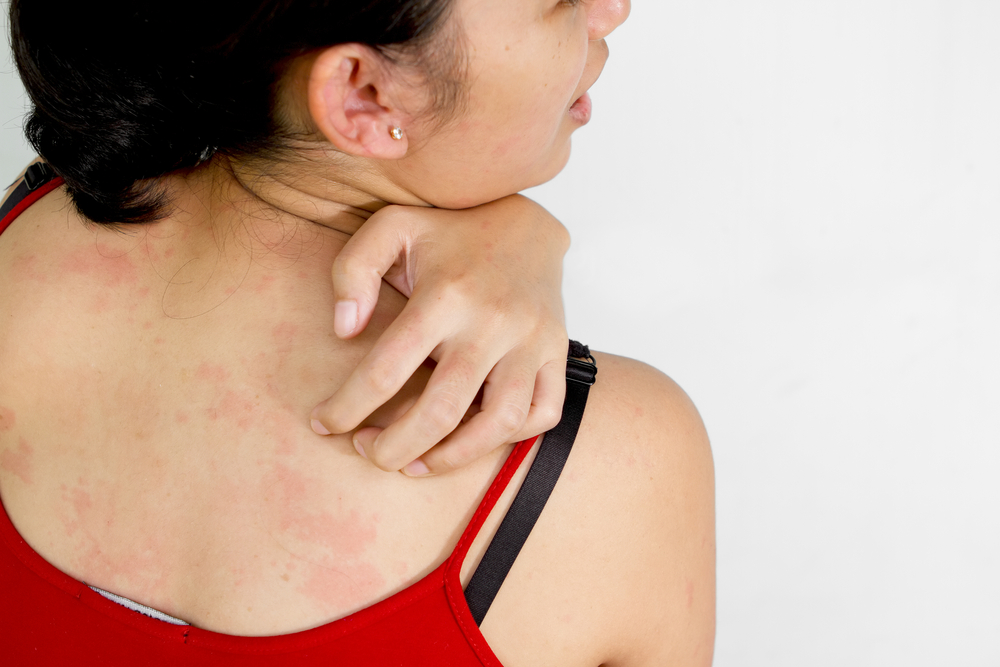
Molluscum (muh-luhs-kum) contagiosum (k∃n-tā-jē-ō-s∃m) is a common skin disease caused by poxvirus. This virus easily spreads from person to person. The only sign of molluscum is pink or flesh-colored bumps on the skin. These bumps can appear anywhere on the skin. Transmission is usually by direct skin contact and occurs in contact sports , sharing baths, towels and gymnasium equipment.
Risk Factor
Causes of molluscum contagiosum
A virus causes molluscum. There are 2 ways to get this virus:
- Touch something infected with the virus. You can get molluscum by using an infected towel. You can get it from touching infected clothing or toys. Wrestlers and gymnasts get it from touching infected mats.
- Direct skin-to-skin contact. Children often get molluscum because they have lots of direct skin-to-skin contact with others. People who participate in contact sports such as wrestling get molluscum from the direct skin-to-skin contact. Teens and adults often get the virus through sexual contact.
Once infected with the virus, a person can spread the virus to other parts the body. Scratching or picking at bumps on the skin and then touching skin that does not have bumps can spread the virus and cause new bumps. Your dermatologist may call this self-re-infection.
Symptoms
Bumps on the skin can be the only sign that a person has molluscum contagiosum. These bumps often appear about 7 weeks after being exposed to the virus that causes molluscum.
When the bumps appear on the skin, they often:
- Begin as small, firm, dome-shaped growths.
- Have a surface that feels smooth, waxy, or pearly.
- Are flesh-colored or pink.
- Have a dimple in the center. The dimple may be filled with a thick, white substance that is cheesy or waxy.
- Are painless, but some bumps itch.
- Turn red as the person’s immune system fights the virus.
- Appear on other areas of the body after a person scratches or picks the bumps. Scratching or picking can spread the virus.
The bumps often appear on the face, neck, armpits, arms, and hands. Other common places for bumps to appear are the genitals, abdomen, and inner thighs. Adults often get molluscum contagiosum through sexual contact.
Treatment Options
There are many treatment options. The treatment prescribed by a dermatologist depends on your age, health, where the bumps appear on your body, and other considerations.
Treatments that a dermatologist can perform in the office to treat molluscum contagiosum include:
- Cryosurgery: The dermatologist freezes the bumps with liquid nitrogen. The liquid nitrogen is administered with the use of a Cry-Ac “gun” in which it is sprayed onto the lesions. This approach allows for a rapid freeze and a slower thaw which is the optimal approach for successful treatment. The treatment may result in burning or stinging sensation for the duration of the spray and then during the thaw period. Typically, after the thaw is complete, pain is unlikely. The treatment may cause a burning or stinging sensation for the duration of the spray and then during the thaw period. Typically, after the thaw is complete, pain is unlikely.
- Curettage: The dermatologist may use a small tool called a curette to scrape the bumps from the skin. Curettage is often painful during the procedure as the curettes themselves are typically sharp and the pressure applied is significant. It is usually reserved for patients with smaller total amounts of molluscum and those who can tolerate the discomfort of the treatment. One advantage is that following the procedure, the molluscum are completely gone and no further treatment other than care of the site is required.
- Laser surgery: A dermatologist uses a laser to target and destroy the bumps. This can be an effective treatment for people who have a weakened immune system. Laser is an effective treatment for visible mulluscum bumps, but will not cure the disease or stop it from spreading. It is a good way to get rid of the ugly-looking bumps in a reasonable time (about 2 weeks), but be prepared to pay a hefty price, and to go back to your dermatologist every few weeks to treat the new ones that will pop up.
- Topical (applied to the skin) therapy: Your dermatologist can apply various acids and blistering solutions to destroy the bumps. These work by destroying the top layers of the skin. Tricholoracetic acid is often used to treat people who have a weak immune system and many bumps.
When a patient has many bumps or large bumps, a dermatologist may need to repeat the procedure every 3 to 6 weeks until the bumps disappear. These procedures cause some discomfort.
Medicines that your dermatologist may prescribe for you to use at home include:
- Imiquimod: This medicine is applied to the bumps. Imiquimod helps your immune system fight the virus. This is strong medicine. It also is used to treat stubborn warts and some skin cancers.
- Retinoid or antiviral medicine applied to the skin: Patients apply this medicine to the bumps as instructed.
While treating the bumps, it is normal for new bumps to appear as others fade.
Ref: